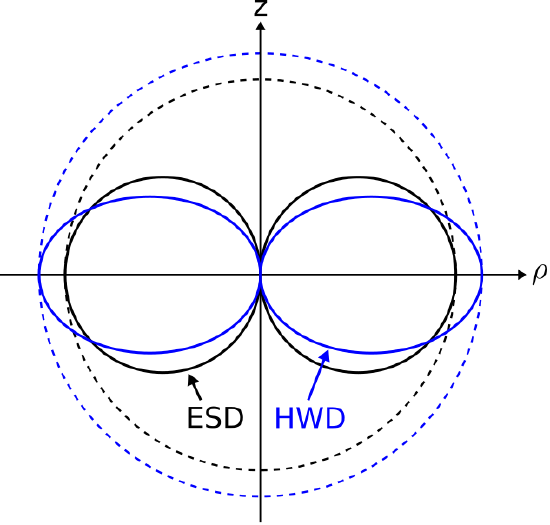22.5: Far-Field Radiation from a Half-Wave Dipole
( \newcommand{\kernel}{\mathrm{null}\,}\)
selected template will load here
This action is not available.
( \newcommand{\kernel}{\mathrm{null}\,}\)
A simple and important current distribution is that of the thin half-wave dipole (HWD), shown in Figure 22.5.1.
 Figure 22.5.1: Current distribution of the half-wave dipole (HWD). ( CC BY-SA 4.0; C. Wang)
Figure 22.5.1: Current distribution of the half-wave dipole (HWD). ( CC BY-SA 4.0; C. Wang)
This is the distribution expected on a thin straight wire having length L=λ/2, where λ is wavelength. This distribution is described mathematically as follows:
˜I(z)≈I0cos(πzL) for |z|≤L2
where I0 (SI base units of A) is a complex-valued constant indicating the maximum magnitude of the current and its phase. Note that the current is zero at the ends of the dipole; i.e., ˜I(z)=0 for |z|=L/2. Note also that this “cosine pulse” distribution is very similar to the triangular distribution of the ESD, and is reminiscent of the sinusoidal variation of current in a standing wave.
Since L=λ/2 for the HWD, Equation ??? may equivalently be written:
˜I(z)≈I0cos(2πzλ)
The electromagnetic field radiated by this distribution of current may be calculated using the method described in Section 9.6, in particular:
˜E(r)≈ˆθjη2e−jβrr(sinθ)⋅[1λ∫+L/2−L/2˜I(z′)e+jβz′cosθdz′]
which is valid for field points r far from the dipole; i.e., for r≫L and r≫λ. For the HWD, the quantity in square brackets is
I0λ∫+λ/4−λ/4cos(2πz′λ)e+jβz′cosθdz′
The evaluation of this integral is straightforward, but tedious. The integral reduces to
I0πcos[(π/2)cosθ]sin2θ
Substitution into Equation ??? yields
˜E(r)≈ˆθjηI02πcos[(π/2)cosθ]sinθe−jβrr
The magnetic field may be determined from this result using Ampere’s law. However, a simpler method is to use the fact that the electric field, magnetic field, and direction of propagation ˆr are mutually perpendicular and related by:
˜H=1ηˆrטE
This relationship indicates that the magnetic field will be +ˆϕ-directed.
The magnitude and polarization of the radiated field is similar to that of the electrically-short dipole (ESD; Section 9.5). A comparison of the magnitudes in any radial plane containing the z-axis is shown in Figure 22.5.2.
 Figure 22.5.2: Comparison of the magnitude of the radiated field of the HWD to that of an electrically-short dipole also oriented along the z-axis. This result is for any radial plane that includes the z-axis. ( CC BY-SA 4.0; C. Wang)
Figure 22.5.2: Comparison of the magnitude of the radiated field of the HWD to that of an electrically-short dipole also oriented along the z-axis. This result is for any radial plane that includes the z-axis. ( CC BY-SA 4.0; C. Wang)
For either current distribution, the maximum magnitude of the fields occurs in the z=0 plane. For a given terminal current I0, the maximum magnitude is greater for the HWD than for the ESD. Both current distributions yield zero magnitude along the axis of the dipole. The polarization characteristics of the fields of both current distributions are identical.
Additional Reading:

